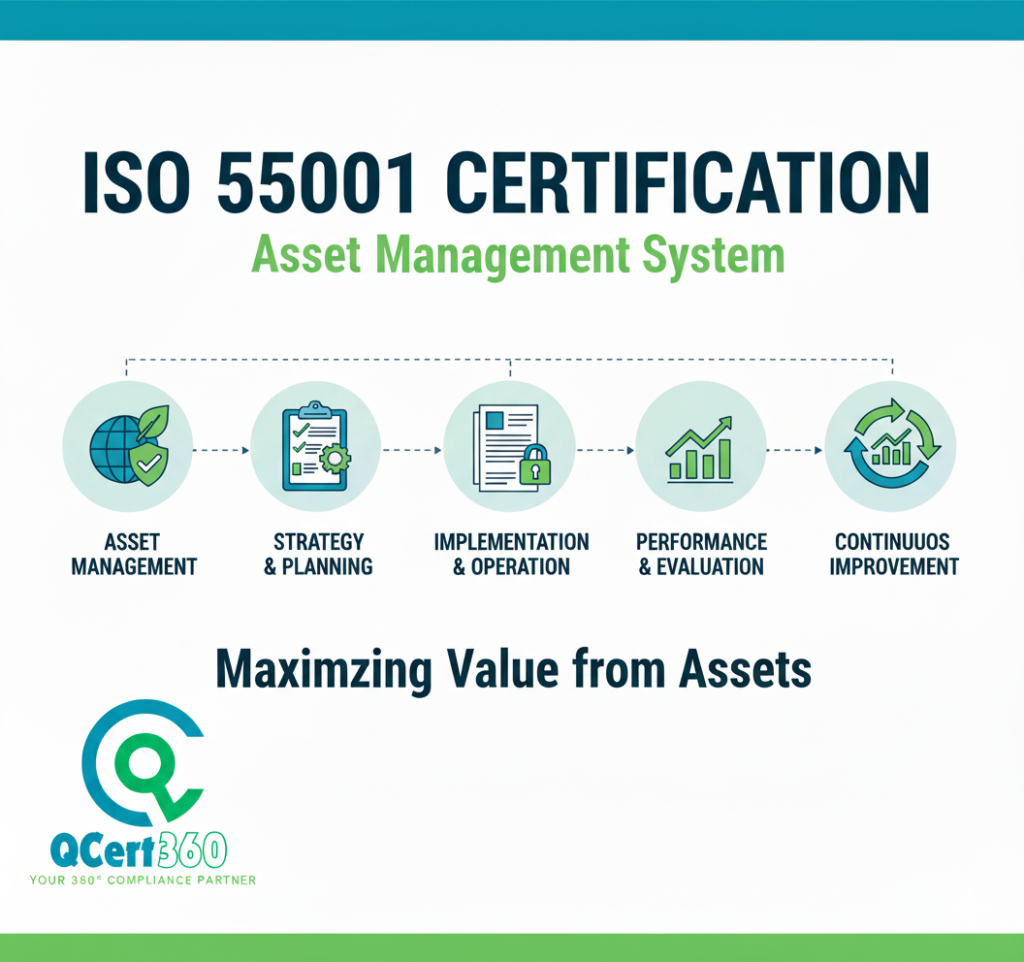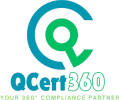ISO 55001:2014 Certification
ISO 55001 is the international standard for Asset Management Systems. It provides a structured framework for organizations to manage the lifecycle of physical and intangible assets effectively, ensuring value creation, risk reduction, and optimized performance. The standard covers planning, acquisition, operation, maintenance, and disposal of assets, aligning them with organizational goals. ISO 55001 emphasizes risk-based decision-making, sustainability, and continual improvement. Certification helps organizations improve efficiency, control costs, and ensure compliance with regulatory and stakeholder requirements. Applicable across industries, ISO 55001 demonstrates a commitment to responsible asset management, long-term resilience, and maximizing return on investment.
Request a Call Back
Get Free Consultation
Have any Questions?
Mail us Today!
contact@qcert360.com
ISO 55001 Certification – Optimizing Asset Management for Sustainable Growth
Managing assets effectively is critical for organizations that depend on infrastructure, equipment, technology, or financial resources to deliver value. Poor asset management can lead to inefficiencies, rising costs, and operational risks. ISO 55001 certification provides a globally recognized framework for establishing a structured asset management system that maximizes performance, reduces risks, and supports long-term sustainability. It ensures organizations meet stakeholder expectations, regulatory requirements, and business objectives with confidence.
What is ISO 55001 certification?
ISO 55001 is an international standard for asset management systems (AMS). It provides guidelines for systematically managing assets across their lifecycle—from acquisition and operation to maintenance and disposal. The standard helps organizations align asset management with business goals, ensuring that resources are optimized for performance, reliability, and sustainability.
Applicable across sectors such as utilities, oil and gas, transport, energy, and manufacturing, ISO 55001 ensures that organizations gain maximum value from their assets while demonstrating accountability and governance.
Why ISO 55001 Certification is important
Organizations today face constant pressure to control costs, reduce downtime, and prove compliance with regulations. Without a structured approach, assets often become underutilized, inefficient, or prone to unexpected failures. This is where ISO 55001 certification makes a difference, helping organizations get the best out of their resources while reducing risks and ensuring long-term sustainability.
Value optimization – Ensures every asset delivers maximum return on investment, whether physical infrastructure, machinery, or financial resources.
Risk management – Proactively identifies and addresses operational, safety, and financial risks linked to asset performance and lifecycle.
Regulatory compliance – Aligns asset management systems with both industry-specific and global legal requirements, avoiding penalties or reputational damage.
Operational performance – Enhances the reliability, efficiency, and availability of assets, improving overall productivity and service delivery.
Stakeholder confidence – Demonstrates transparency, accountability, and responsible governance, strengthening trust with investors, customers, and regulators.

Benefits:
Enhanced Marketability:
Obtaining certification boosts brand visibility and credibility, making products and services more attractive to consumers and increasing market share in global markets.
Consumer Trust & Satisfaction:
Certification assure customers of consistent quality, safety, and reliability, fostering trust, increasing brand loyalty, and ensuring higher levels of customer satisfaction.
Regulatory Compliance
Certification ensure compliance with global standards and regulations, helping businesses avoid legal issues, penalties, and enabling smoother entry into diverse international markets.
Competitive Advantage
Holding certification distinguishes a business from competitors, signaling superior quality and reliability, and positioning the company as an industry leader in the market.
Global Expansion
Certification provide access to new international markets, demonstrating that a business meets global standards, which facilitates expansion and opens doors to new business opportunities worldwide.
Risk Mitigation & Efficiency
Certifications help identify and mitigate risks, streamline operations, and reduce errors or defects, ensuring efficiency and consistency while safeguarding against operational disruptions.
What are the core Components of ISO 55001 Certification
ISO 55001 works in harmony with broader management systems but brings a dedicated focus to asset management. Its framework ensures organizations can maximize asset value while minimizing risks. The key components include:
Leadership and Governance – Establishing clear accountability for asset management at every level of the organization, supported by strong leadership commitment.
Strategic Planning – Ensuring asset management strategies are aligned with overall business goals, long-term vision, and stakeholder expectations.
Lifecycle Management – Managing assets through every stage—from acquisition and use to maintenance and eventual disposal—to maximize value and reliability.
Risk-Based Approach – Identifying potential risks that could impact asset performance, and putting proactive controls in place to minimize disruptions.
Performance Evaluation – Tracking, measuring, and analyzing asset efficiency, reliability, and contribution to organizational objectives.
Compliance and Documentation – Maintaining accurate records to demonstrate adherence to legal, regulatory, and industry requirements.
Continuous Improvement – Regularly reviewing performance, adapting to changing markets, and evolving practices as new risks and technologies emerge.
Benefits of ISO 55001 Certification for your organization
Achieving ISO 55001 certification provides organizations with a structured and measurable approach to managing assets. The key benefits include:
Optimized resource utilization – Ensures assets are used efficiently, reducing lifecycle costs and avoiding unnecessary expenditure.
Enhanced reliability and availability – Improves the performance of critical assets, minimizing unplanned downtime and disruptions.
Improved financial planning – Provides better visibility into asset-related costs, enabling stronger budgeting and return on investment.
Reduced risks – Lowers the likelihood of asset failures, safety incidents, and regulatory non-compliance.
Transparency and accountability – Strengthens decision-making by documenting processes and responsibilities clearly.
Reputation and stakeholder trust – Demonstrates a commitment to sustainable governance, reassuring clients, regulators, and investors.
Long-term sustainability – Supports resilient growth by aligning asset management practices with environmental, social, and economic objectives.
Who Needs to get ISO 55001 Certification?
ISO 55001 is relevant to any organization that depends on assets—whether physical, financial, or technological—to deliver value. Industries that benefit most include:
Utilities and Energy Providers – Maximizing efficiency and reliability in power plants, grids, pipelines, and renewable systems.
Oil, Gas, and Petrochemicals – Managing high-value, safety-critical assets while ensuring regulatory compliance and safety.
Transportation and Logistics – Keeping fleets, vehicles, and infrastructure in peak condition to reduce downtime and operational costs.
Manufacturing and Production – Optimizing machinery, production lines, and facilities for higher output and reduced maintenance costs.
Financial Institutions – Managing intangible assets like IT systems, technology, and data infrastructure.
Government Agencies – Overseeing public infrastructure, transportation systems, and essential utilities with greater accountability.
In short, any organization that wants to reduce costs, enhance performance, and improve asset governance can benefit from ISO 55001 certification.
Continuous Improvement with ISO 55001 certification
Continuous improvement is at the heart of ISO 55001. The standard requires organizations to regularly measure performance, monitor asset condition, and review the effectiveness of their management practices. Risks are continuously assessed, with corrective and preventive actions built into routine operations. This proactive approach ensures that asset strategies evolve alongside advances in technology, updates in regulations, and shifts in market demands. By embedding improvement into everyday decision-making, organizations can extend asset lifecycles, reduce waste, and increase overall reliability. More importantly, it creates a culture where innovation and accountability go hand in hand. The result is an asset management system that not only meets current needs but also prepares the organization for future challenges and opportunities.
Conclusion: How to get ISO 55001 Certification with the help of Qcert360
ISO 55001 certification is not just about meeting compliance requirements—it’s about unlocking the full potential of your assets. By implementing this internationally recognized framework, organizations gain stronger control over their asset lifecycle, optimize resource allocation, reduce operational risks, and secure long-term financial stability. More importantly, it reinforces stakeholder trust by demonstrating accountability, transparency, and sustainable governance.
At Qcert360, we bring extensive experience in guiding organizations across industries through the ISO 55001 certification journey. Our approach covers every stage of the process—conducting gap analysis, designing asset management strategies, training staff, and preparing for successful audits. We simplify complex requirements into practical steps tailored to your business objectives. With Qcert360 as your partner, certification becomes more than a checkbox—it becomes a catalyst for continuous improvement and strategic growth. Together, we help organizations establish resilient, future-ready asset management systems that deliver measurable value year after year.
Sectors & Industries we serve
Our Services
ISO Standards
- ISO 9001 Certification
- ISO 14001 Certification
- ISO 45001 Certification
- ISO 22000 Certification
- ISO 17025 Certification
- ISO 27001 Certification
- ISO 13485 Certification
- ISO 20000-1 Certification
- ISO 41001 Certification
- ISO 22716 Certification
- ISO 50001 Certification
- ISO 22301 Certification
- ISO 29993 Certification
Product Certifications
Other international standards
- FSSC 22000 Certification
- HIPAA
- HACCP Certification
- SA 8000 Certification
- GMP Certification
- GDPR
- GDP Certification
- GLP Certification
- Certificate of Conformity


